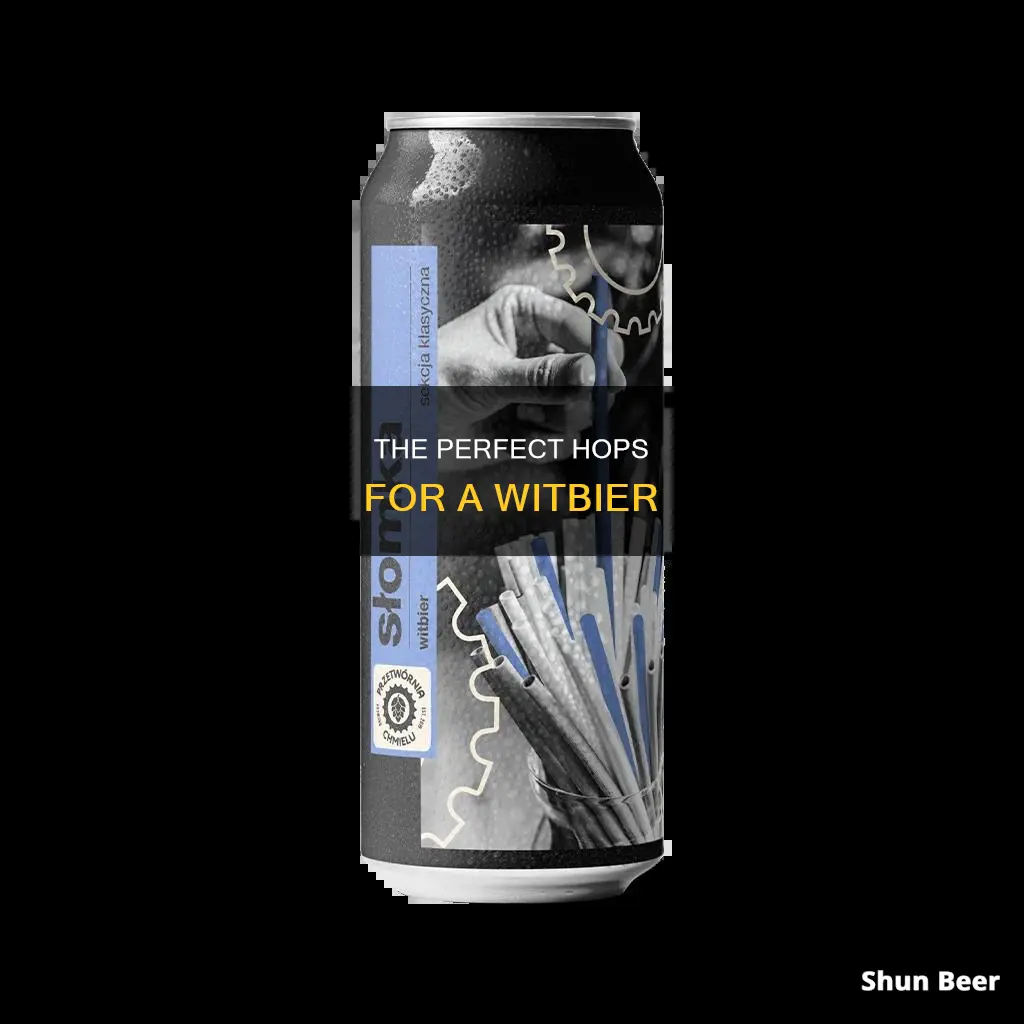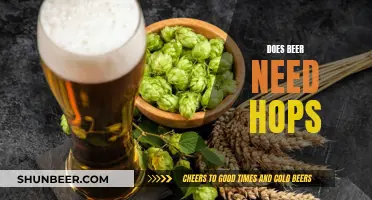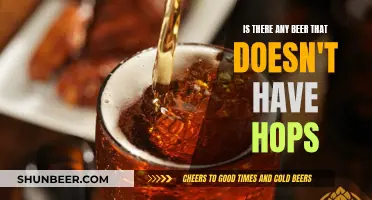
When it comes to hops for wit beer, it's important to remember that this style of beer is not meant to be hoppy. The hops used in wit beer are primarily for bittering, with low alpha hops being the preferred choice. Some common hops used in wit beer include Styrian Goldings, Saaz, Kent Goldings, and Hallertau. Late hopping, dry hopping, and large late hop additions are generally not recommended for this style. The goal is to minimise the hop profile and avoid overpowering the other flavours in the beer, particularly the spices.
What You'll Learn

Low-alpha hops are best
When it comes to brewing wit beer, low-alpha hops are the way to go. While all hops contain acids and oils that impart bitterness, flavour, and stability to the finished beer, it's the low-alpha variety that shines in more delicate beers.
In the world of hops, alpha acids are the key players when it comes to bitterness. High alpha hops, also known as "super alphas", pack a punch with 10% alpha acid or higher. These hops are the go-to choice for brewers looking to create intensely bitter beers. However, when crafting a more nuanced brew like wit beer, low-alpha hops take centre stage.
Low-alpha hops typically have an alpha acid content of around 5%, and they are added to the boil to release their bittering qualities. While they may contribute less bitterness per ounce compared to their high-alpha cousins, they are the star ingredient in more subtle, nuanced beers. These hops are often chosen for their delicate aromatic qualities, adding depth of flavour and aroma without overwhelming the palate.
One of the key advantages of low-alpha hops is their ability to deliver a more pronounced flavour and aroma. Brewers seeking to create a well-rounded, complex beer often turn to these hops to achieve the perfect balance of bitterness, aroma, and flavour. By adding low-alpha hops later in the boil, brewers can preserve the aromatic oils that would otherwise be destroyed during a longer boiling process. This technique ensures that the final product boasts a delightful bouquet without sacrificing the desired level of bitterness.
Additionally, low-alpha hops offer brewers versatility and creativity in their craft. With a range of varieties to choose from, brewers can experiment with different combinations to achieve unique flavour profiles. Whether it's a subtle hint of citrus or a delicate floral note, low-alpha hops provide the perfect canvas for brewers to paint with, resulting in a beer that's both refreshing and intriguing.
Hoppy Beer, Happy Life: The Ultimate Guide to Hopping
You may want to see also

Spicing is important
When brewing a witbier, it is a good idea to start with a small-scale prototype batch to get a feel for the spices. Spice scaling is not linear, so it is better to err on the side of caution and have a batch that is a bit too subtle rather than one that is overpowering. If the spices are too weak, they can be boosted by soaking them in unflavoured vodka or liqueur to make what is known as "potions". However, when adding sweet orange, liqueurs may add too much residual sweetness without the firm bitterness of dried peel.
One of the challenges of brewing a witbier is getting the right balance of sweet and bitter flavours. The bitter orange peel provides a firm bitterness that offsets the smoothness of the oats and the sweetness of the sweet orange. Too much sweet orange can make the beer taste cloying, while too much bitter orange can make it overly tart. Finding the right balance between these flavours is key to brewing a successful witbier.
In addition to the spices, witbiers are also characterised by their light golden colour, cloudy appearance, and high carbonation. The original gravity is typically in the 1.044-1.052 range, with bitterness in the 10-20 IBU range and colour in the 2-5 SRM range. The base malt is usually pale malt, with unmalted wheat making up the other half of the grain bill. Rolled or flaked oats may also be added to enhance body and flavour.
Hops in Beer: Vegetable or Not?
You may want to see also

Avoid late hop additions
When brewing witbier, it's important to consider the timing of your hop additions. While late hopping can be a great way to add aroma and flavour to your beer, there are a few reasons why you might want to avoid late hop additions.
Firstly, late hopping may not be suitable for all beer styles. If you're brewing a non-hoppy beer, such as a witbier, where the focus is more on the yeast and malt characteristics, late hopping may not be necessary. In fact, adding too much hops late in the boil could overpower the delicate spice and fruit notes that are characteristic of witbiers.
Secondly, late hopping may not provide the desired level of bitterness. When hops are added early in the boil, the alpha acids present in the hops isomerize into iso-alpha-acids, which contribute a significant amount of bitterness. However, during late hopping, the shorter boil time limits isomerization, resulting in less bitterness. While some bitterness can still be achieved with late hopping, it may not be sufficient for certain beer styles.
Another reason to avoid late hop additions is the potential loss of aroma. The highly volatile hop oils that contribute aroma to your beer can be easily boiled off, especially if added too early or boiled for too long. By the time the wort cools down, many of those delicate aromatics will have escaped with the steam. Therefore, late hopping may not be the best method if you're looking for a strong hop aroma in your beer.
Additionally, late hopping may not be the most efficient use of hops. To achieve the desired level of bitterness with late hopping, you would need to use a larger quantity of hops compared to early addition hops. This could increase your brewing costs and may not be the best option if you're looking to brew on a budget.
Finally, while late hopping can be a great technique for adding complexity to your beer, it might not be necessary for every batch. Sometimes, keeping it simple with just a single early addition of hops can result in a perfectly enjoyable beer. Overcomplicating the process with multiple late additions might detract from the overall balance and drinkability of your witbier.
Hop Head Beers: A Guide to Bitter Brews
You may want to see also

Dry hopping is an option
Hops are the cone-shaped flowers of the female hops plant, Humulus lupulus. They contain alpha acids and oils that impart bitterness, flavour, and stability to the beer. The role they play in the brewing process depends on when they are added. When added early, they contribute bitterness; when added later, they infuse the beer with a more "hoppy" aroma.
Dry hopping is a brewing term for adding hops late in the brewing process—either during fermentation or conditioning. The term originated with British brewers, who added hops to casks shortly before shipping them to the customer. Today, dry hopping refers to any addition of hops after the wort has been cooled. These additions can be done in the primary fermenter, in the secondary, or by adding hops directly to a keg.
The benefit of dry hopping is that it allows brewers to get as much flavour and aroma as possible into the final beer. This technique gives the beer a floral hop essence and an intense flavour desirable in hoppy beer styles like pale ales and IPAs. Some commercial examples of dry-hopped beers include Sierra Nevada's Celebration Ale, Young's Special Ale, Anchor Liberty, and Sam Adams Pale Ale.
When dry hopping, brewers usually select a hop variety considered a "flavour" or "aroma" hop. These hops typically have relatively low alpha acid ratings, often around 6% or less. Some common varieties used for dry hopping include Cascade, Crystal, Willamette, East Kent Golding, Fuggle, Saaz, Hallertau, and Tettnanger.
There are several methods for dry hopping beers. The most common approach is filling nylon bags with hops and suspending them inside fermentation tanks. However, some brewers choose to add hops directly to the top of the fermentation tanks or create a slurry that is shot into the tank via pressurised pipes.
The choice of when to add the hops during dry hopping is also important. While dry hopping in the primary fermenter will work, conventional wisdom suggests that the secondary fermenter is the best place. This is because the vigorous CO2 activity of the primary fermentation can scrub out some of the hop aromas, defeating the purpose of dry hopping. Additionally, the alcohol and low pH of the secondary fermenter help ward off any bacteria on the un-sanitised hops.
Dry hopping is an excellent option for brewers looking to enhance the aroma and flavour of their beer without increasing bitterness. By adding hops late in the brewing process, brewers can emphasise the aromatic and flavourful qualities of hops while minimising the extraction of bittering qualities.
Hops to Beer: Acres of Fun and Flavor
You may want to see also

Original gravity is key
Original gravity (OG) is a key consideration when brewing a wit beer, as it dictates whether the desired alcohol by volume (ABV) will be achieved. OG is a measure of the density of a wort compared to water, specifically the ratio of the density of a sample to the density of water. In the context of brewing, gravity is the measure of a liquid's density relative to water at a specified temperature.
OG is crucial in the brewing process as it helps brewers estimate how many sugars can be converted to alcohol and, ultimately, determine the final strength of the beer. It is a measure of the fermentable and unfermentable substances in a beer wort before fermentation, which are often the sugars that will be converted to alcohol. By measuring the original gravity, brewers can get an idea of the potential alcohol content in the final product.
To calculate the OG, brewers use a hydrometer or similar instrument to get a specific gravity (SG) reading. The SG reading compares the density of the beer (or wort) to the density of water, which has a specific gravity of 1.000. For example, if a stout has an SG reading of 1.090, it means that it is 9% denser than water and likely contains 9% sugar.
When it comes to wit beer, the original gravity is usually around 11–12 °P (1.044–1.048). This indicates that wit beer has a relatively low original gravity compared to bigger beers like American Barleywines and Imperial Stouts, which can surpass 1.100.
In summary, understanding and controlling original gravity is key to producing a successful wit beer, as it directly impacts the final ABV and overall character of the brew.
Micolob Beer's Hoppy Secret: What's Inside?
You may want to see also
Frequently asked questions
Low-alpha hops such as Styrian Goldings, Saaz, Kent Goldings, Hallertauer, Fuggles, or BC Goldings are recommended for wit beer.
Use just enough hops to balance the sweetness of the malt. The bitterness range for wit beer is 10-20 IBU.
The principal addition should be for bittering. Late hopping is inappropriate, as hop aroma is not a feature of the style.
While it is not recommended, some homebrewers have experimented with dry hopping wit beers using hops such as Cascade, Citra, Amarillo, Centennial, and Hallertau.
In addition to hops, wit beers are spiced with coriander and the peels of both sweet and bitter oranges. Oats and malted barley are also sometimes used.







